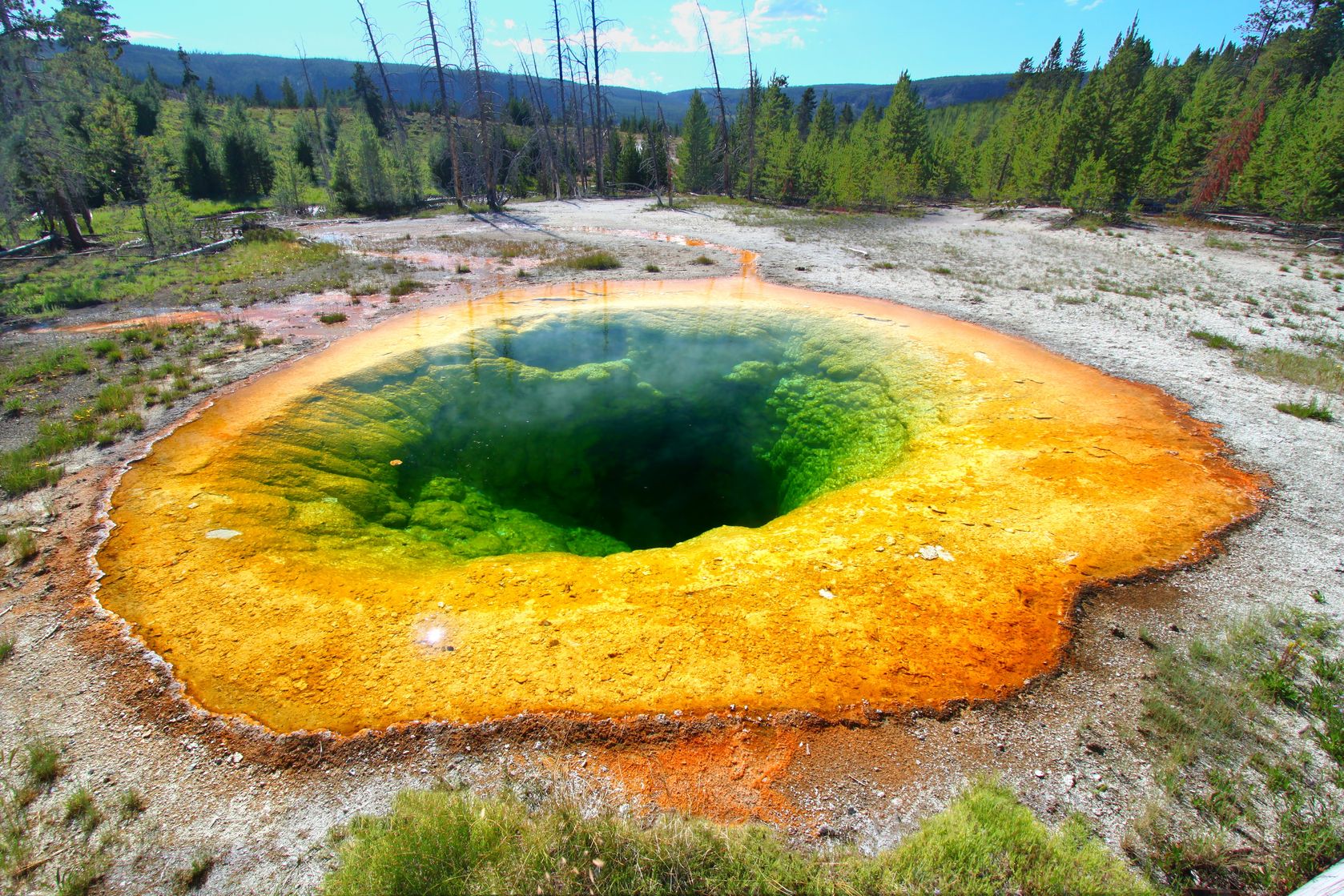What Happened On Yellowstone: The Complete Story You Need To Know
Yellowstone is more than just a national park; it’s a geological wonderland that has fascinated scientists, tourists, and adventurers alike for centuries. But what happened on Yellowstone? Well, buckle up, because this story is as wild as the park itself. From volcanic eruptions to mysterious animal migrations, there’s a lot to unpack here, and we’re diving deep into the heart of it all.
If you’ve ever wondered why Yellowstone is such a hot topic—pun intended—you’re not alone. The park is home to one of the most active supervolcanoes on the planet, and its history is packed with drama, mystery, and scientific intrigue. So, whether you’re a geology geek, a nature lover, or just someone who likes a good story, this article is for you.
Before we get into the nitty-gritty, let’s set the stage. Yellowstone National Park spans across Wyoming, Montana, and Idaho, and it’s been around for millions of years. But don’t let its age fool you—this place is anything but static. From massive eruptions to subtle shifts in the earth’s crust, Yellowstone is alive and kicking. Let’s explore what happened on Yellowstone and why it matters.
- Angela Alvarez The Inspiring Journey Of A Remarkable Woman
- Denzel Washington Oscars Wins The Iconic Journey Of A Legendary Actor
Table of Contents
- Introduction to Yellowstone
- Yellowstone's Volcanic History
- Geysers and Hot Springs
- Wildlife Migrations in Yellowstone
- Earthquake Activity
- Human Impact on Yellowstone
- Scientific Research in Yellowstone
- Future Predictions for Yellowstone
- Visitor Experience at Yellowstone
- Conclusion
Introduction to Yellowstone
Yellowstone National Park is a place of unparalleled beauty and scientific significance. Established in 1872, it was the world’s first national park, setting a precedent for conservation efforts worldwide. But beyond its picturesque landscapes and abundant wildlife, Yellowstone harbors a dark secret—a supervolcano that has the potential to reshape the planet.
So, what happened on Yellowstone? To understand the park’s history, we need to look back millions of years. The Yellowstone Caldera, the massive volcanic crater that forms the heart of the park, has erupted three times in the past: 2.1 million years ago, 1.3 million years ago, and 630,000 years ago. Each eruption was cataclysmic, spewing ash and lava across vast distances and reshaping the landscape forever.
But don’t panic just yet. While the supervolcano is still active, scientists believe it’s unlikely to erupt anytime soon. That said, the park remains a hotspot for geological activity, and its history is a fascinating tale of nature’s power and resilience.
- Damon Wayans Jr Height The Inside Scoop On The Stars Measurements And Career
- Brad Pitts Children The Untold Story Youve Been Waiting For
Yellowstone's Volcanic History
Let’s dive into the nitty-gritty of Yellowstone’s volcanic past. The park sits atop a hotspot—a plume of magma that rises from deep within the Earth’s mantle. This hotspot has been moving across the continent for millions of years, leaving a trail of volcanic activity in its wake.
Major Eruptions
- The first major eruption occurred 2.1 million years ago and was so massive that it created the Huckleberry Ridge Tuff, a layer of volcanic rock that stretches across much of the western United States.
- Fast forward 800,000 years, and the second eruption formed the Mesa Falls Tuff, a smaller but still significant event.
- The most recent eruption, 630,000 years ago, created the Lava Creek Tuff and the Yellowstone Caldera as we know it today.
Each of these eruptions was thousands of times more powerful than the infamous Mount St. Helens eruption in 1980. The ash from these events blanketed much of North America, altering the climate and reshaping ecosystems.
Geysers and Hot Springs
One of the most iconic features of Yellowstone is its geothermal activity. The park is home to over 500 geysers and thousands of hot springs, mud pots, and fumaroles. These natural wonders are a direct result of the underlying volcanic activity.
Old Faithful
Perhaps the most famous geyser in the world, Old Faithful erupts every 60 to 90 minutes, shooting hot water and steam high into the air. Its predictability makes it a must-see for visitors, but there’s more to it than meets the eye. Old Faithful’s eruptions are influenced by seismic activity and changes in the water table, making it a valuable tool for scientists studying the park’s geology.
Grand Prismatic Spring
Another highlight of Yellowstone is the Grand Prismatic Spring, the largest hot spring in the United States. Its vibrant colors, ranging from deep blue to fiery red, are the result of heat-loving microorganisms that thrive in the extreme conditions. It’s a reminder of just how extraordinary life can be.
Wildlife Migrations in Yellowstone
Yellowstone isn’t just a geological wonder—it’s also a wildlife paradise. The park is home to an incredible array of animals, from grizzly bears and wolves to bison and elk. And every year, these animals embark on incredible migrations that are as fascinating as they are vital to the ecosystem.
Bison Migration
One of the most iconic migrations in Yellowstone is that of the bison. These majestic creatures move between summer and winter ranges, following the availability of food and water. Their movements are closely monitored by park rangers and scientists, who study their behavior to better understand the park’s ecology.
Wolves and Their Role
When wolves were reintroduced to Yellowstone in the 1990s, it marked a turning point for the park’s ecosystem. Their presence has helped restore balance to the food chain, keeping populations of herbivores in check and allowing vegetation to thrive. It’s a testament to the power of reintroducing apex predators to their natural habitats.
Earthquake Activity
Yellowstone is no stranger to earthquakes. In fact, the park experiences hundreds of small tremors every year, most of which go unnoticed by visitors. But occasionally, larger earthquakes occur, reminding us of the park’s volatile nature.
The 1959 Hebgen Lake Earthquake
One of the most significant earthquakes in Yellowstone’s history occurred in 1959 near Hebgen Lake. Measuring 7.3 on the Richter scale, the quake caused massive landslides and reshaped the landscape. It was a stark reminder of the power of the Earth’s crust and the importance of monitoring seismic activity in the park.
Human Impact on Yellowstone
While Yellowstone is a natural wonder, it’s not immune to the effects of human activity. Climate change, pollution, and over-tourism are all taking their toll on the park, and efforts are underway to mitigate these impacts.
Climate Change
Rising temperatures are affecting the park’s ecosystems in myriad ways. Glaciers are retreating, rivers are drying up, and species are struggling to adapt. Scientists are working tirelessly to study these changes and develop strategies to protect the park’s biodiversity.
Tourism Management
With millions of visitors each year, managing tourism in Yellowstone is a delicate balancing act. The park service is implementing measures to reduce congestion, minimize waste, and promote sustainable practices. It’s a challenge, but one that’s essential for preserving this national treasure.
Scientific Research in Yellowstone
Yellowstone is a living laboratory for scientists around the world. Its unique combination of geological, biological, and ecological features makes it an ideal place to study everything from volcanic activity to microbial life.
Volcanology
Researchers are constantly monitoring the Yellowstone Caldera for signs of volcanic activity. Using advanced technology, they track ground deformation, gas emissions, and seismic activity to better understand the supervolcano’s behavior. Their work is crucial for predicting potential eruptions and ensuring public safety.
Microbiology
The hot springs and geysers of Yellowstone are home to some of the most extreme forms of life on Earth. Scientists are studying these microorganisms to learn more about the origins of life and the potential for life on other planets. It’s a field of research that’s both exciting and groundbreaking.
Future Predictions for Yellowstone
So, what does the future hold for Yellowstone? While it’s impossible to predict with certainty, scientists have developed models and scenarios based on current data. These predictions range from minor geological changes to catastrophic eruptions, but most agree that the park will continue to evolve in fascinating ways.
Volcanic Eruptions
While a full-blown supervolcano eruption is unlikely in the near future, smaller eruptions could occur at any time. These events would likely be localized and not as devastating as the major eruptions of the past. Still, they would serve as a reminder of the park’s dynamic nature.
Climate Change
As the planet continues to warm, Yellowstone’s ecosystems will face increasing challenges. Species may migrate to new areas, water sources may dwindle, and wildfires may become more frequent. It’s a sobering thought, but one that underscores the importance of conservation efforts.
Visitor Experience at Yellowstone
For those lucky enough to visit Yellowstone, the experience is nothing short of awe-inspiring. From the towering geysers to the roaming wildlife, there’s something for everyone in this vast wilderness. But to truly appreciate the park, it’s important to understand its history and significance.
Tips for Visitors
- Plan your trip during the shoulder seasons (spring or fall) to avoid crowds.
- Respect wildlife by keeping a safe distance and never feeding animals.
- Stay on designated trails to protect fragile ecosystems.
- Bring plenty of water and snacks, as amenities can be sparse in remote areas.
Conclusion
What happened on Yellowstone? The answer is both simple and complex. This incredible park has been shaped by millions of years of geological activity, and its story is far from over. From volcanic eruptions to wildlife migrations, Yellowstone is a testament to the power and resilience of nature.
As visitors and stewards of this remarkable place, it’s our responsibility to protect it for future generations. By supporting conservation efforts, reducing our carbon footprint, and educating ourselves about the park’s history and science, we can ensure that Yellowstone remains a source of wonder and inspiration for years to come.
So, what are you waiting for? Grab your hiking boots, pack your camera, and head to Yellowstone. It’s an adventure you won’t soon forget—and one that just might change the way you see the world.



Detail Author:
- Name : Leland Kub
- Username : anais.kub
- Email : cmcclure@hintz.com
- Birthdate : 1999-10-12
- Address : 4099 Larson Squares Langoshhaven, NM 83685-1940
- Phone : 260.682.4081
- Company : Tromp PLC
- Job : Fast Food Cook
- Bio : Nemo vero recusandae eum qui expedita. Non vitae dolorem fugiat similique odit iusto. Est omnis et corporis blanditiis similique. Excepturi eveniet nesciunt unde et.
Socials
tiktok:
- url : https://tiktok.com/@raywiegand
- username : raywiegand
- bio : Nesciunt veniam ut enim.
- followers : 3323
- following : 2075
twitter:
- url : https://twitter.com/raywiegand
- username : raywiegand
- bio : Eum maxime aut repellendus libero et. Perferendis porro omnis consectetur tempora architecto. Quo magnam et voluptatem harum labore numquam.
- followers : 3298
- following : 2942
instagram:
- url : https://instagram.com/rwiegand
- username : rwiegand
- bio : Nostrum minima neque accusamus distinctio rerum soluta saepe. Aut et quia voluptatibus.
- followers : 1988
- following : 60